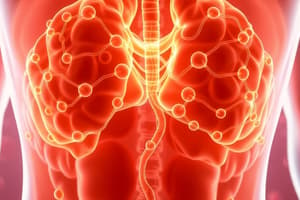Podcast
Questions and Answers
What topic is covered in Week 6 of the course?
What topic is covered in Week 6 of the course?
- Mitochondrial Therapeutics
- Cell Signaling III-IV (correct)
- Bioenergetics
- Obesity
Which of the following is NOT listed as a topic in the course schedule?
Which of the following is NOT listed as a topic in the course schedule?
- Inflammation
- Muscle Metabolism (correct)
- Cell Signaling I
- Redox Biology
During which week is the topic 'Obesity' discussed?
During which week is the topic 'Obesity' discussed?
- Week 1
- Week 4
- Week 5
- Week 3 (correct)
Which week includes the topic 'Alzheimer’s II'?
Which week includes the topic 'Alzheimer’s II'?
What is the first topic covered in Week 1 of the course?
What is the first topic covered in Week 1 of the course?
What unique aspect of lipid metabolism is introduced in Week 2?
What unique aspect of lipid metabolism is introduced in Week 2?
In what session are the biochemical processes of fat and NSAIDs addressed?
In what session are the biochemical processes of fat and NSAIDs addressed?
Which topic is covered in Week 5 alongside Mitochondrial Therapeutics?
Which topic is covered in Week 5 alongside Mitochondrial Therapeutics?
Which enzyme catalyzes the conversion of pyruvate into phosphoenolpyruvate in the mitochondria?
Which enzyme catalyzes the conversion of pyruvate into phosphoenolpyruvate in the mitochondria?
Which of the following enzymes is inhibited by ADP during gluconeogenesis?
Which of the following enzymes is inhibited by ADP during gluconeogenesis?
What is the primary role of acetyl-CoA in the process of gluconeogenesis?
What is the primary role of acetyl-CoA in the process of gluconeogenesis?
Which of the following statements about the irreversible reactions in glycolysis is true?
Which of the following statements about the irreversible reactions in glycolysis is true?
What substrate is produced by the action of pyruvate carboxylase?
What substrate is produced by the action of pyruvate carboxylase?
Which GLUT protein is most highly expressed in the human erythrocyte membrane?
Which GLUT protein is most highly expressed in the human erythrocyte membrane?
Which class of GLUT proteins includes GLUT5?
Which class of GLUT proteins includes GLUT5?
What is a key function of GLUT1 in the human body?
What is a key function of GLUT1 in the human body?
Which condition is associated with GLUT2 deficiency?
Which condition is associated with GLUT2 deficiency?
In which tissue is GLUT4 primarily expressed?
In which tissue is GLUT4 primarily expressed?
What is a major clinical implication of altered GLUT1 levels?
What is a major clinical implication of altered GLUT1 levels?
Which GLUT protein is primarily associated with neuronal glucose uptake?
Which GLUT protein is primarily associated with neuronal glucose uptake?
GLUT6 is primarily distributed in which tissues?
GLUT6 is primarily distributed in which tissues?
Which disorder is associated with increased GLUT4 expression?
Which disorder is associated with increased GLUT4 expression?
Which GLUT class includes GLUT10?
Which GLUT class includes GLUT10?
What happens to lactate utilization in liver diseases?
What happens to lactate utilization in liver diseases?
What physiological condition does not require oxygen for lactate production?
What physiological condition does not require oxygen for lactate production?
What substance is the precursor for the synthesis of cortisol?
What substance is the precursor for the synthesis of cortisol?
What is the primary metabolic pathway for erythrocytes to produce ATP?
What is the primary metabolic pathway for erythrocytes to produce ATP?
During the synthesis of cortisol, which enzyme is responsible for converting pregnenolone to progesterone?
During the synthesis of cortisol, which enzyme is responsible for converting pregnenolone to progesterone?
In the liver, which enzyme does cortisol activate to increase gluconeogenesis?
In the liver, which enzyme does cortisol activate to increase gluconeogenesis?
What is a consequence of pyruvate kinase deficiency in erythrocytes?
What is a consequence of pyruvate kinase deficiency in erythrocytes?
What is the main function of the Cori Cycle?
What is the main function of the Cori Cycle?
In cases of ethanol intoxication, what impact is observed on lactate levels?
In cases of ethanol intoxication, what impact is observed on lactate levels?
Which of the following metabolites is produced after 11-deoxycortisol in the cortisol synthesis pathway?
Which of the following metabolites is produced after 11-deoxycortisol in the cortisol synthesis pathway?
Which of the following conditions does NOT contribute to hypoxia?
Which of the following conditions does NOT contribute to hypoxia?
How do glycolytic pathways in muscle cells respond to intense exercise?
How do glycolytic pathways in muscle cells respond to intense exercise?
Which molecular compartment is primarily involved in the conversion of pregnenolone to 17a-hydroxy-progesterone?
Which molecular compartment is primarily involved in the conversion of pregnenolone to 17a-hydroxy-progesterone?
What action does cortisol perform to enhance hepatic glucose production?
What action does cortisol perform to enhance hepatic glucose production?
What is the role of Na,K–ATPase in erythrocytes?
What is the role of Na,K–ATPase in erythrocytes?
What role does PEPCK serve in the process of gluconeogenesis?
What role does PEPCK serve in the process of gluconeogenesis?
What major product is formed from glucose during glycolysis?
What major product is formed from glucose during glycolysis?
Cortisol synthesis involves several steps starting from cholesterol. Which step follows the conversion of pregnenolone?
Cortisol synthesis involves several steps starting from cholesterol. Which step follows the conversion of pregnenolone?
What effect does hypoxia have on lactate levels?
What effect does hypoxia have on lactate levels?
Which process does the Cori Cycle primarily support during high-intensity exercise?
Which process does the Cori Cycle primarily support during high-intensity exercise?
Flashcards are hidden until you start studying
Study Notes
Course Information
- Course ID: PhrD515
- Title: Metabolism and Cell Biology
- Class Schedule: Mondays 09:00 AM – 12:00 PM (Synchronous)
- Location: PSC108
- Coordinator: Enrique Cadenas
- Office: PSC614
- Contact: [email protected]
- Office Hours: By appointment, Wednesdays 3:00-4:00 PM
Weekly Schedule Overview
- Week 1: Carbohydrate Metabolism I & II, Bioenergetics
- Week 2: Biochemistry of Fat and NSAIDs, Lipid Metabolism
- Week 3: Dietary Lipids and Lipoproteins, Obesity, Atherosclerosis
- Week 4: Starve/Feed Cycle, Synthesis of cortisol
- Week 5: Mitochondrial Therapeutics, Cell Signaling I-IV
- Week 6: Redox Biology, Inflammation
- Week 7: Alzheimer’s I & II
Cortisol Synthesis
- Cortisol is synthesized in mitochondria from cholesterol, initially converted to pregnenolone.
- Pregnenolone is transformed to progesterone in the endoplasmic reticulum.
- Sequential transformations lead to 17a-hydroxy-progesterone and then to 11-deoxycortisol, which is ultimately metabolized to cortisol.
Role of Cortisol in Gluconeogenesis
- Cortisol binds to the Glucocorticoid Responsive Gene (GRG) upon translocating to the nucleus.
- Activates transcription of P-EnolPyruvate Carboxykinase (PEPCK), enhancing hepatic glucose production.
- PEPCK catalyzes the conversion of oxaloacetate to P-enol pyruvate in the cytosol.
The Cori Cycle
- Describes conversion of lactate from skeletal muscle into glucose in the liver; glucose is then returned to the muscle for ATP production.
GLUT Protein Classification
- Human GLUT proteins are categorized into three classes based on specificity:
- Class I: GLUT1, GLUT2, GLUT3, GLUT4, GLUT14
- Class II: GLUT5, GLUT7, GLUT9, GLUT11
- Class III: GLUT6, GLUT8, GLUT10, GLUT12
GLUT1 Function
- Highly expressed in erythrocytes, brain, and maternal-placental transfer of glucose.
- Essential for brain glucose uptake, especially across the blood-brain barrier.
- Deficiency can lead to seizures, developmental delay, and neurobehavioral symptoms.
- Upregulation is linked to tumor progression in cancers.
GLUT2 Characteristics
- High-capacity, bidirectional transporter primarily found in the liver, islets of Langerhans, kidney, and intestine.
- Plays a significant role in glucose homeostasis and lactate utilization in various physiological conditions.
Glycolysis and Clinical Correlations
- Pyruvate kinase deficiency leads to hemolytic anemia due to impaired ATP production in erythrocytes.
- Regulatory reactions in glycolysis (irreversible) include hexokinase, phosphofructokinase, and pyruvate kinase.
- Reactions bypassed in gluconeogenesis are facilitated by different enzymes like pyruvate carboxylase and phospho-fructo phosphatase.
Gluconeogenesis Pathways
- Pyruvate conversion to phospho-enol-pyruvate occurs in two steps:
- In mitochondria by pyruvate carboxylase (stimulated by acetyl-CoA).
- In cytosol by PEP-CK (inhibited by ADP).
Studying That Suits You
Use AI to generate personalized quizzes and flashcards to suit your learning preferences.



